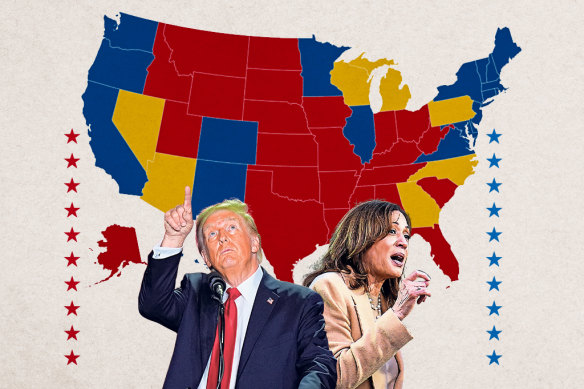Harris had 71 different paths to the White House. Only one faint hope remains
There are 538 members of the Electoral College, meaning a candidate must get 270 electors to win the presidency. There are a number of paths to this outcome.

There are seven key states – and multiple paths to victory.Credit: Marija Ercegovac
The winner of the US presidential election will govern a nation of more than 330 million people, but the contest could be decided by just tens of thousands of voters in a handful of states.
The president is not decided solely on the popular vote. Instead, under the Electoral College system, the winning candidate in each state and Washington, D.C., receives that state’s Electoral College votes, which are largely based on population.
There are 538 members of the Electoral College, meaning a candidate must get 270 electors (one more than half) to win the presidency.
All states except Maine and Nebraska have a winner-take-all policy, meaning whoever wins the state’s popular vote gets the entirety of its college votes. The system means a candidate can win the popular vote, as Hillary Clinton did in 2016, but lose the election on the Electoral College count.
Opinion polls suggest that only seven of the 50 states have been truly competitive this year. The rest are all comfortably Democratic or Republican. The seven battleground states have been the Rust Belt trio of Michigan, Pennsylvania and Wisconsin and the Sun Belt quartet of Arizona, Georgia, Nevada and North Carolina.
Before polls opened, Harris had 71 different combinations from those states to get her to 270. But with Georgia and North Carolina already called for Trump, and the former president performing strongly in the others there appears to be only one path left for the vice president.
Through much of this campaign, Harris has led the polls in the key states of Wisconsin, Michigan and Pennsylvania, claiming all three would give her exactly 270 seats and her most straightforward path to victory. While there are other possible options for her to achieve victory, this these three states, the “blue wall” or “Rust Belt” is her last real chance. All remain too close to call but Trump leads the count in all three.
While ahead in the count in the remaining five battleground states, even if he only wins Pennsylvania, Trump will have the 270 votes he needs to return to the White House.
If he loses Pennsylvania, he still has a path to the White House. In this scenario, Trump wins some key Sun Belt states – Nevada, Arizona, North Carolina and Georgia, a geographical region comprising the south-east to the south-west. But doing so would leave him agonisingly close on 268, meaning he would require victory in one of the Rust Belt states, such as Wisconsin.
Could history repeat itself and Trump replicates the same path that gave him victory in 2016? To do so, he’d have to win a patchwork of Rust Belt, southern and western Sun Belt states.
Get a note direct from our foreign correspondents on what’s making headlines around the world. Sign up for the weekly What in the World newsletter here.